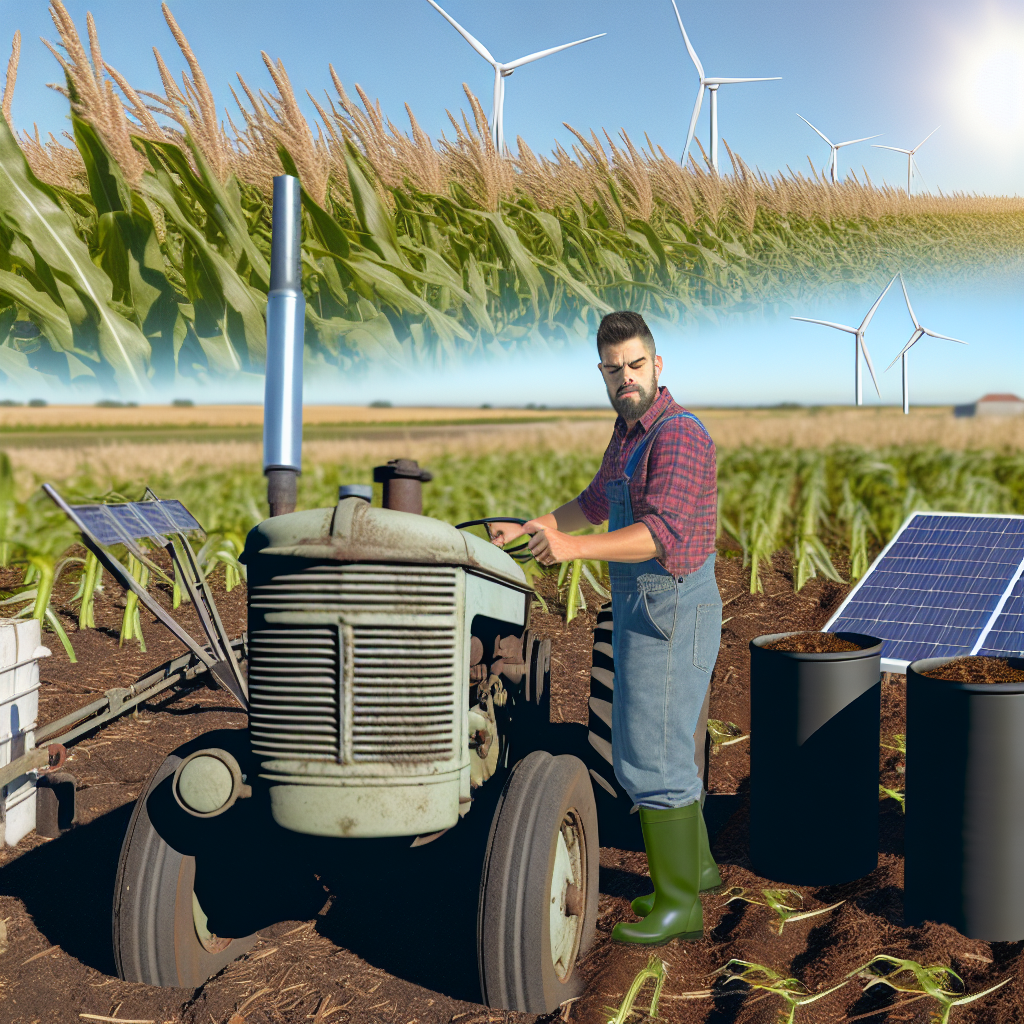Introduction to Sustainable Farming and Its Importance
Defining Sustainable Farming
Sustainable farming refers to agricultural practices that prioritize environmental health.
This method emphasizes conserving resources while promoting biodiversity.
Additionally, it aims to reduce reliance on synthetic fertilizers and pesticides.
Benefits for the Environment
Sustainable farming fosters soil health through crop rotation and cover cropping.
It also enhances water quality by minimizing runoff and erosion.
Moreover, it helps in mitigating climate change by sequestering carbon in soils.
This approach encourages diverse ecosystems which support various species.
Social and Economic Impact
Sustainable farming contributes to local economies by promoting food sovereignty.
It creates jobs and fosters community engagement in agricultural practices.
Farmers adopting sustainable methods often see improvements in yield and quality.
Furthermore, consumers benefit from healthier food options and local produce.
Addressing Global Challenges
This farming method is crucial for addressing food security concerns worldwide.
It plays a role in adapting to climate variability and unforeseen agricultural challenges.
By implementing sustainable practices, farmers prepare for future demands on food systems.
Consequently, it helps build resilience against shocks and stresses in agriculture.
Transform Your Agribusiness
Unlock your farm's potential with expert advice tailored to your needs. Get actionable steps that drive real results.
Get StartedOverview of Insurance Solutions Available for Farmers
Importance of Insurance in Farming
Insurance plays a crucial role in modern farming practices.
Farmers face various risks in crop production and livestock management.
Hence, insurance solutions help mitigate these risks effectively.
Additionally, insurance fosters more stable income for farmers.
It encourages sustainable practices by providing financial security.
Types of Insurance Available
Farmers can choose from a variety of insurance types.
Crop insurance is one of the most common options.
This insurance protects against losses due to natural disasters.
Additionally, livestock insurance covers a range of animal health issues.
Farmers can also consider property insurance for equipment and facilities.
Crop Insurance
Crop insurance primarily comes in two forms: Actual Production History (APH) and Revenue Protection (RP).
APH focuses on protecting against yield loss.
Meanwhile, RP covers revenue losses from reduced yields or prices.
Both types can enhance financial stability for farmers.
Livestock Insurance
Livestock insurance provides coverage for various animal-related risks.
This includes health issues, accidents, and theft.
Additionally, some policies cover loss due to natural disasters.
Hefty investments in livestock make this insurance essential.
Support Programs and Benefits
Several support programs enhance insurance accessibility for farmers.
The Federal Crop Insurance program offers premium subsidies.
These subsidies significantly reduce insurance costs for farmers.
Moreover, risk management education programs inform farmers about their options.
This knowledge empowers them to make informed decisions.
Government Incentives
Government agencies often provide additional incentives for sustainable practices.
Showcase Your Farming Business
Publish your professional farming services profile on our blog for a one-time fee of $200 and reach a dedicated audience of farmers and agribusiness owners.
Publish Your ProfileThese may include lower premiums for eco-friendly farming methods.
Farmers can benefit from reduced costs while promoting sustainability.
Challenges in Accessing Insurance
Despite the available solutions, farmers face several challenges.
Many struggle to understand the insurance policies available.
Complicated terms and conditions can deter farmers from purchasing insurance.
Furthermore, certain innovative practices may not be well-covered.
Future Directions in Agricultural Insurance
The landscape of agricultural insurance continues to evolve.
As sustainable practices gain traction, so will relevant insurance options.
Farmers can anticipate more tailored solutions in the future.
Continued advancements will help address emerging agricultural risks.
Types of Insurance Products for Sustainable Practices
Crop Insurance
Crop insurance protects farmers against losses due to natural disasters.
This includes droughts, floods, or pest infestations.
Additionally, it ensures financial stability during difficult seasons.
Farmers can choose from multiple coverage options tailored to their needs.
Liability Insurance
Liability insurance covers potential damages or injuries caused by farming activities.
This is essential for protecting landowners from lawsuits.
Moreover, it can offer coverage for accidents that occur on the farm.
Agricultural operations often face risks that can escalate quickly.
Property Insurance
Property insurance safeguards farm buildings and equipment.
Farmers rely on these tools for efficient operations.
In case of theft or damage, this coverage can significantly reduce losses.
Furthermore, it can cover loss of income during repair or replacement periods.
Environmental Liability Insurance
Environmental liability insurance addresses pollution and other environmental impacts.
This type of insurance is becoming increasingly essential as regulations tighten.
Farmers can manage risks related to chemical spills or soil contamination.
It provides peace of mind while promoting responsible farming practices.
Agri-tourism Insurance
Agri-tourism insurance protects farms that host visitors for tours or events.
As more farms diversify, this coverage is vital for attracting tourists.
This insurance can handle liabilities associated with on-site activities.
It encourages farms to explore new revenue streams and sustainable practices.
Specialty Insurance Products
Many insurance companies now offer specialty products tailored to unique farming practices.
These can include coverage for organic farming or alternative crops.
Such products ensure specific risks associated with innovative farming methods are addressed.
Farmers benefit from enhanced support for their sustainability efforts.
Uncover the Details: Farm Liability Insurance: What You Need to Know
Risk Assessment in Sustainable Farming
Understanding Risks in Agriculture
Risk assessment plays a crucial role in sustainable farming.
It identifies potential challenges farmers may face.
Farmers must consider environmental, economic, and social risks.
Additionally, these risks impact the entire agricultural ecosystem.
Analyzing these risks allows for better decision-making.
Showcase Your Farming Business
Publish your professional farming services profile on our blog for a one-time fee of $200 and reach a dedicated audience of farmers and agribusiness owners.
Publish Your ProfileTypes of Risks in Sustainable Farming
- Environmental risks include climate change and soil degradation.
- Economic risks involve market fluctuations and input costs.
- Social risks encompass labor issues and community relations.
Each type of risk requires a unique approach.
Farmers must evaluate and prioritize which risks to address first.
Evaluating Environmental Risks
Environmental risks threaten the sustainability of farming practices.
Farmers should regularly assess the health of their land.
Soil erosion and water scarcity are significant concerns.
Implementing sustainable practices can mitigate these risks.
For instance, crop rotation improves soil health.
Evaluating Economic Risks
Economic risks can significantly affect farm profitability.
Market analysis helps farmers anticipate price changes.
Moreover, diversifying crops can protect against financial losses.
Farmers should also consider securing lines of credit.
This flexibility can help manage unexpected costs.
Evaluating Social Risks
Social risks relate not only to labor but also to community involvement.
Strong community ties foster support for sustainable practices.
Engaging with local stakeholders can build positive relationships.
Furthermore, providing fair labor conditions enhances worker loyalty.
Implementing Risk Mitigation Strategies
Farmers should develop comprehensive risk management plans.
These plans should address each risk type identified.
Training and education play pivotal roles in preparation.
Additionally, investing in insurance can safeguard against losses.
- Consider crop insurance for financial protection.
- Invest in technology to monitor environmental health.
- Participate in community programs to strengthen support networks.
Ultimately, proactive risk management can lead to sustainable success.
Discover More: How Collaborations Boost Sustainable Farm Productivity
Case Studies: Successful Implementation of Insurance in Sustainable Farming
Urban Harvest Farms
Urban Harvest Farms utilizes crop insurance effectively.
They focus on sustainable practices to enhance productivity.
With flexible policies, they mitigate risks from climate variabilities.
Their insurance covers unexpected weather events.
As a result, they maintain financial stability each season.
Green Fields Agro
Green Fields Agro demonstrates innovative insurance solutions.
They promote organic farming while ensuring coverage for losses.
By partnering with insurance providers, they access tailored plans.
This strategy protects against pest infestations and diseases.
Consequently, they maintain their organic certification and profitability.
Eco Valley Produce
Eco Valley Produce implemented a comprehensive insurance package.
This package addresses both yield loss and market fluctuations.
They engaged in educational programs to raise awareness.
Farmers learned how insurance can safeguard their investments.
This initiative improved crop resilience and financial security.
Sunrise Orchard
Sunrise Orchard adopted an agro-forestry model with insurance support.
They secured coverage for both crops and trees.
This dual coverage fosters biodiversity and improves soil quality.
Showcase Your Farming Business
Publish your professional farming services profile on our blog for a one-time fee of $200 and reach a dedicated audience of farmers and agribusiness owners.
Publish Your ProfileInsurance aids in recovery after storm damage or drought.
Therefore, they ensure economic viability through diverse income streams.
Willow Creek Farm
Willow Creek Farm enhanced its sustainability with smart insurance choices.
They utilize technology to monitor and report conditions.
This proactive approach minimizes risks before they escalate.
Insurance claims are processed efficiently thanks to data accuracy.
Thus, they achieve higher recovery rates after losses.
See Related Content: Business Continuity Planning for Agribusiness

Financial Benefits of Insurance for Sustainable Farming Practices
Reducing Financial Risks
Insurance helps farmers mitigate financial risks effectively.
It provides a safety net during adverse weather conditions.
This coverage ensures that farmers can recover from losses faster.
Consequently, farmers can maintain their operations without interruption.
Encouraging Investment in Sustainable Practices
Insurance can incentivize investments in eco-friendly technologies.
Farmers feel more secure when insured against potential risks.
As a result, they are more likely to adopt sustainable practices.
This leads to a positive environmental impact overall.
Improving Access to Financing
Insurance policies enhance farmers’ ability to access credit.
Lenders often view insurance as a sign of reduced risk.
Additionally, insured farms can negotiate better loan terms.
This access leads to increased capital for improving farming practices.
Meeting Regulatory Requirements
Many sustainable agricultural initiatives require insurance coverage.
Compliance with regulations can provide financial benefits.
Insurance helps farmers meet these regulatory standards easily.
Consequently, this can lead to grants or subsidies opportunities.
Boosting Market Competitiveness
Insurance coverage allows farmers to compete more effectively.
They can take calculated risks without incurring severe losses.
This competitive edge can improve their market position.
In turn, it leads to higher revenue and profitability.
Delve into the Subject: Using Technology to Boost Your International Farming Business
Challenges and Barriers to Accessing Insurance for Farmers
Understanding the Current Insurance Landscape
Farmers face numerous challenges when accessing insurance products.
The insurance landscape is often complex and hard to navigate.
Many traditional policies do not cover sustainable farming practices.
This creates a gap for farmers who want to adopt eco-friendly methods.
High Premium Costs
Insurance premiums can be prohibitively high for small-scale farmers.
For instance, rates for organic farms are often higher than conventional ones.
This discourages many farmers from seeking necessary coverage.
Consequently, they risk financial ruin during adverse weather events.
Lack of Tailored Solutions
Insurance products often lack customization for diverse farming methods.
Sustainable practices vary widely across different crops and regions.
Farmers require policies that address the unique risks these practices pose.
Showcase Your Farming Business
Publish your professional farming services profile on our blog for a one-time fee of $200 and reach a dedicated audience of farmers and agribusiness owners.
Publish Your ProfileWithout tailored solutions, many farmers remain uninsured or underinsured.
Limited Awareness and Understanding
Many farmers are unaware of available insurance options.
This lack of knowledge hinders their ability to secure proper coverage.
Additionally, misconceptions about insurance processes create barriers.
Education on sustainable solutions can empower farmers significantly.
Regulatory and Policy Hurdles
Government policies often do not support sustainable farming insurance.
Existing regulations can complicate the insurance acquisition process.
Furthermore, inconsistent policy frameworks limit access to innovative products.
Advocacy for policy reform is a crucial step for change.
Building Trust with Insurers
Farmers frequently experience distrust toward insurance companies.
Past negative experiences can sour relationships with insurers.
Establishing transparency and communication is vital for building trust.
Cultivating long-term partnerships can enhance farmers’ confidence in insurance.
Future Trends in Insurance Solutions for Sustainable Agriculture
The Rise of Customized Insurance Products
Insurance providers increasingly offer tailored products for sustainable farming.
These products address the unique risks associated with eco-friendly practices.
Farmers are starting to seek coverage that aligns with their sustainability goals.
Customized insurance plans include options for organic certification and sustainable methods.
Incorporating Technology into Insurance Solutions
Technology plays a crucial role in the future of agricultural insurance.
Farmers now use data analytics to assess risks more accurately.
Remote sensing and drones provide real-time insights about crop health.
This information enables insurers to adjust policies based on actual conditions.
Insurance companies benefit from reduced claims and better risk management.
Enhancing Risk Assessment Models
Advanced risk assessment models are emerging in agricultural insurance.
These models frequently incorporate climate data to predict potential losses.
Additionally, they evaluate the environmental impact of farming practices.
This comprehensive approach helps insurers set appropriate premiums.
Farmers can thus access more affordable and fair insurance options.
Encouraging Sustainable Practices through Incentives
Incentive-based insurance plans promote sustainable farming practices.
Farmers may receive premium discounts for using eco-friendly methods.
Such incentives encourage more farmers to adopt sustainable techniques.
Insurance providers align their offerings with broader environmental goals.
This trend leads to healthier ecosystems and more resilient agricultural communities.
Collaboration between Stakeholders
Collaboration among various stakeholders is crucial for innovative insurance solutions.
Partnerships between insurers, farmers, and environmental organizations are becoming common.
These collaborations lead to the development of holistic insurance programs.
Sharing knowledge and resources enhances the understanding of sustainable practices.
Consequently, these initiatives stabilize the farming industry and promote growth.
The Impact of Government Policies
Government policies increasingly influence the insurance landscape for sustainable farming.
Policies that support green initiatives create new opportunities for insurance providers.
Regulations can encourage investment in eco-friendly farming technologies.
Showcase Your Farming Business
Publish your professional farming services profile on our blog for a one-time fee of $200 and reach a dedicated audience of farmers and agribusiness owners.
Publish Your ProfileMoreover, government-backed insurance programs can help mitigate risks.
This support fosters resilience in the agricultural sector.
Additional Resources
Research – Department of Agricultural Economics
Farmers Employ Strategies To Reduce Risk of Drought … – USDA ERS




